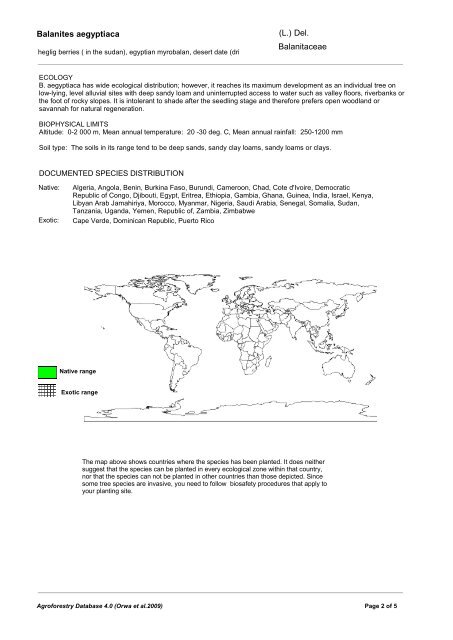Balanites aegyptiaca Balanitaceae - World Agroforestry Centre
Balanites aegyptiaca Balanitaceae - World Agroforestry Centre
Balanites aegyptiaca Balanitaceae - World Agroforestry Centre
Create successful ePaper yourself
Turn your PDF publications into a flip-book with our unique Google optimized e-Paper software.
<strong>Balanites</strong> <strong>aegyptiaca</strong><br />
heglig berries ( in the sudan), egyptian myrobalan, desert date (dried fruit)<br />
(L.) Del.<br />
<strong>Balanitaceae</strong><br />
ECOLOGY<br />
B. <strong>aegyptiaca</strong> has wide ecological distribution; however, it reaches its maximum development as an individual tree on<br />
low-lying, level alluvial sites with deep sandy loam and uninterrupted access to water such as valley floors, riverbanks or<br />
the foot of rocky slopes. It is intolerant to shade after the seedling stage and therefore prefers open woodland or<br />
savannah for natural regeneration.<br />
BIOPHYSICAL LIMITS<br />
Altitude: 0-2 000 m, Mean annual temperature: 20 -30 deg. C, Mean annual rainfall: 250-1200 mm<br />
Soil type: The soils in its range tend to be deep sands, sandy clay loams, sandy loams or clays.<br />
DOCUMENTED SPECIES DISTRIBUTION<br />
Native:<br />
Exotic:<br />
Algeria, Angola, Benin, Burkina Faso, Burundi, Cameroon, Chad, Cote d'Ivoire, Democratic<br />
Republic of Congo, Djibouti, Egypt, Eritrea, Ethiopia, Gambia, Ghana, Guinea, India, Israel, Kenya,<br />
Libyan Arab Jamahiriya, Morocco, Myanmar, Nigeria, Saudi Arabia, Senegal, Somalia, Sudan,<br />
Tanzania, Uganda, Yemen, Republic of, Zambia, Zimbabwe<br />
Cape Verde, Dominican Republic, Puerto Rico<br />
Native range<br />
Exotic range<br />
The map above shows countries where the species has been planted. It does neither<br />
suggest that the species can be planted in every ecological zone within that country,<br />
nor that the species can not be planted in other countries than those depicted. Since<br />
some tree species are invasive, you need to follow biosafety procedures that apply to<br />
your planting site.<br />
<strong>Agroforestry</strong> Database 4.0 (Orwa et al.2009)<br />
Page 2 of 5

















